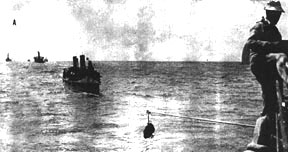American Merchant Marine in Spanish-American War
In 1895, when the Armed Forces again had a great need for oceangoing ships, the Merchant Marine was no longer in a position to supply all of the required shipping as it had done in the past, because it had dwindled away to such an extent that American ships were carrying only 10 percent of the exports of the United States. The Army and Navy had to buy foreign vessels and had to take care of their own ship operating requirements by establishing sea transportation services.
At the outbreak of the war with Spain the Quartermaster had only 10 small harbor boats and was unprepared for a large overseas movement. The Navy was well equipped with warships to fight a war with a weak country like Spain, but they lacked supply ships and coaling facilities, both at home and abroad.
When war was declared, the Navy had warships in Hong Kong without a single auxiliary, so they purchased two ships: the Nanshan with 3,000 tons of coal on board, and the Zafiroto carry supplies. These ships accompanied Admiral Dewey's warships when he sailed to Manila Bay.
The magnitude of his victory at Manila Bay solved Dewey's most serious logistic problems in the Pacific, since he could now await the arrival of the two colliers and an ammunition ship purchased on the west coast of the United States for his use.
The blockade of Cuba required the maintenance of a naval force constantly at sea, but the Navy was not prepared to provide the coal required for this operation without periodically withdrawing ships. Equipment for coaling at sea was not available. Private firms feared to supply coal to the West Indies and the Bureau of Equipment had to buy steamers, convert them into colliers, and provide them with crews and officers.

The Invasion Fleets
The Rough Riders under Colonel Theodore Roosevelt faced almost unbelievable congestion and chaos at Port Tampa when they set out for the invasion of Cuba. The ships which the Quartermaster's Department chartered in June 1898 for transporting troops, animals, and supplies to Cuba could transport only 16,000 men rather than the planned 25,000 men. Thanks to a calm sea and feeble Spanish resistance, the overcrowded transports reached Santiago, Cuba in safety and both Cuba and Puerto Rico were occupied by American forces.
In May 1898, an invasion fleet consisting of 17 chartered and 2 purchased steamers were converted into troop-carrying vessels at San Francisco for the conquest of the Philippines. These ships were sent over in five different convoys, and, since the voyage involved a distance of more than 7,000 miles, great care was taken in their conversion. The conquest of the Philippines was achieved only through a constant flow of troops and supplies from San Francisco.
Source: Military Sea Transportation and Shipping Control, Bureau of Naval Personnel, Navpers10829-A, Washington, DC 1954
Memorial Ceremonies Honor Spanish-American War Veterans in 1922
Books about Merchant Marine in Spanish-American War
6/5/00
www.USMM.org ©1998-2001. You may quote material on this web page as long as you cite American Merchant Marine at War, www.usmm.org, as the source. You may not use more than a few lines without permission. If you see substantial portions of this page on the Internet or in published material please notify usmm.org @ comcast.net